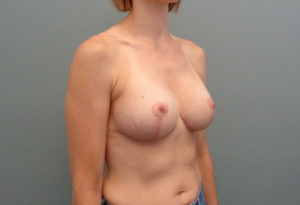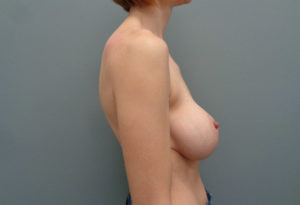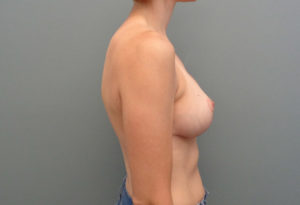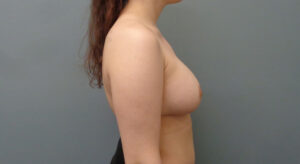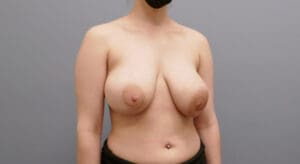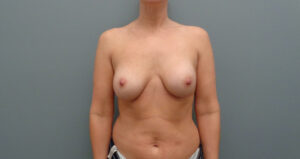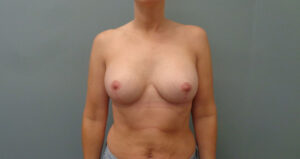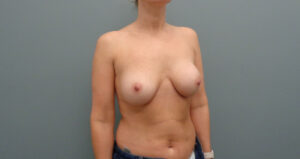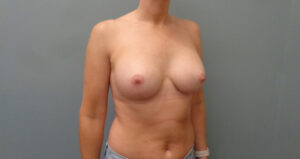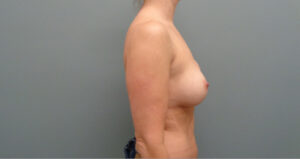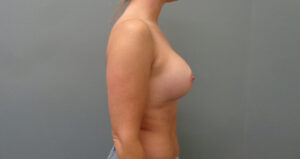Chad Robbins, M.D., F.A.C.S., is a Mayo Clinic-trained, board-certified plastic surgeon who performs breast implant exchanges and revisions for women who live in and near the Nashville and Franklin areas. Breast implant revision is often medically necessary for women who suffer from leaking implants and capsular contracture or hardening of the breast implant, but the procedure is most often performed on women who want to change their breast cups size.
What is Breast Implant Exchange?
Breast implant revision is a surgical procedure where existing breast implants are removed and replaced with a new pair of implants. This procedure may be medically necessary or initiated by the patient’s personal choice. Cosmetic procedures are often performed during or after breast implant exchange surgeries to ensure an aesthetically pleasing outcome. Many patients who undergo this surgery often choose to switch the type of implant used to augment the breasts or combine their revision surgery with a breast lift procedure.
The breast implants that a woman initially chooses may not work for her personal image or life circumstances down the line. Some women may feel like their initial choice of implants were too conservative, while other women may feel that their first choice of implants was too large. As long as candidates are in good health and understand the limitations of the procedure, breast implant exchange is a viable option in both cases.
Before & After Pictures
Implant Exchnage 8400
Implant Exchnage 10786
Implant Exchnage 11615
Candidates for Breast Implant Revision Surgery
Capsular Contracture
Capsular contracture is one of the leading causes of breast implant replacement. This condition develops when scar tissue encapsulates the breast implant, causing it to harden over time. This painful complication is difficult and frustrating for both patients and their surgeons. Capsular contracture develops at a higher rate when breast implants are placed behind the breast tissue and over the pectoral muscle. Patients who receive subpectoral breast implants tend to develop scar tissue at a lower rate.
In more complex cases, the patient may need a capsulotomy or capsulectomy to release or remove the scar tissue from the breast cavity. In cases where the scar tissue returns following removal, we’ve experienced high success rates in treating these recurrent bouts of capsular contracture using both human and porcine dermal matrices. We are really excited about this breakthrough treatment that enables us to slow or prevent the formation of capsular contracture.
Bottoming Out of Implants
Over time, gravity and skin laxity will cause the weight of breast implants, especially larger implants, to stretch the breast skin and lower the breasts below the breast crease, giving way to a “bottom heavy” or bottomed-out appearance. Failure to wear a supportive bra on a regular basis will only worsen the condition over time. Dr. Robbins can reverse this condition using a technique that lifts and permanently anchors the breasts in a higher position. Sutures are then stitched into the breast cavity surrounding the implant to elevate the breast crease and place the implant in the proper position. This procedure not only reshapes the breast into a more natural appearance, but it also creates more attractive and proportionate cleavage.
Lateral Displacement of Implants
Lateral breast displacement is another reason many women seek breast augmentation revision surgery. Careful dissection of the breast pocket at the time of the initial breast augmentation is the best way to prevent lateral displacement of the implant. This condition causes the breast implant to disappear or move into the armpit when a woman lies down, but this problem is often effectively resolved with a capsulorrhaphy suture. This specialized suture creates a line of demarcation or breast border that prevents the implant from moving laterally. Dr. Robbins has been able to effectively and permanently resolve this problem for this group of patients using this technique.
Implant Rupture
The latest generation of saline and silicone breast implants have some of the lowest rupture rates ever, but implant leaks still occur in rare instances. Implant tears occur for a number of reasons, but fold-flaw failure is the most common cause of implant ruptures and tears. Fold-flaw failure is characterized by overlapping folds of the implant onto itself. As the folds overlap and rub together, they cause the implant to weaken and rupture at the fold point. It’s important to replace a ruptured implant as soon as possible to prevent scar tissue and/or contracture from developing. Failure to remove a ruptured implant in a timely manner will eventually lead to scar tissue formation, which may make removal or replacement more challenging. Scar tissue formation may also make it more difficult for our surgeon to recreate a balanced and attractive breast shape.
Desire to Increase or Decrease Implant Size
The desire to change the volume of one’s implants is perhaps the number one non-medical reason women seek breast implant revision surgery. If the implant size you initially chose is now too small and you would like to increase your breast size, Dr. Robbins will take your body size and shape into consideration before recommending an implant that will accommodate your desired look. He may also suggest exchanging older generation saline implants for newer silicone cohesive-gel implants. These modern silicone implants are commonly referred to as the “gummy bear” implant for their more durable, yet pliable and natural-looking consistency and shape.
On the contrary, some women may wish to exchange a larger implant for a smaller size. Many women feel that their initial choice of implant is now too large as their lifestyle and the image they’re trying to project changes with age. Downsizing implants comes with its own set of issues, such as skin laxity and the need for an internal tightening of the breast pocket to better accommodate a smaller implant. Dr. Robbins has received extensive training in the latest techniques for downsizing implants, and his approach will help you achieve the smaller, natural-looking breast size you desire.
Breast Implant Removal
If a woman chooses to have her breast implants removed or explanted, an additional breast lift procedure may be unnecessary. A breast lift is sometimes performed following implant removal to correct skin laxity, reduce breast droop, and improve the overall appearance of the breasts. The procedure’s necessity largely depends on a variety of individual factors, including the amount of breast tissue present prior to augmentation, the size of the implant, and texture and elasticity of the skin.
Whether you want a smaller breast shape or a more voluptuous bust, breast implant exchange surgery can help you achieve your ideal look. The breasts naturally expand in some women as their breast implants cause the skin to loosen and stretch, and, in some cases, the breasts may even shrink as the breast tissue stretches and involutes over the breast implant. Either of these problems can create an unbalanced, disproportionate silhouette, especially after childbirth or dramatic weight loss. At Robbins Plastic Surgery, we use varying styles of implants and state-of-the-art breast implant revision techniques to help our patients achieve their ideal breast size and shape.
While breast implant exchange can help a number of women, the procedure is not suitable for:
- Women who suffer from precancerous breast disorders or untreated breast cancer
- Women who suffer from any type of existing infection
- Pregnant and nursing women
- Women who suffer from a weakened or significantly impaired immune system
- Women who suffer from certain medical disorders
- Women who suffer from restricted blood flow in the breast tissue
Blood clotting disorders, anticoagulant medications, and medications that interfere with wound healing could increase the potential risks of any surgery, including breast implant revision. Inadequate blood clotting can make any surgery unsafe, and poor wound healing can make recovery painful and diminish the results of surgery. Inadequate blood flow in the breast tissue is usually linked to past surgeries or radiation therapy. If you show signs of reduced blood flow in your breasts, Dr. Robbins will need to further evaluate your condition before clearing you for breast implant revision surgery.
The Breast Implant Exchange Procedure
To a certain extent, breast implant exchange is performed in the same manner as the initial augmentation, But Dr. Robbins may need to include an extra step to remove any existing scar tissue from the breast area. Dr. Robbins prefers to place incisions and perform revision surgery along the scars from the initial breast augmentation whenever possible. Once the incisions are placed, Dr. Robbins will carefully extract the existing implant from the breast cavity, and if your silicone implants have ruptured, he’ll thoroughly remove any silicone residue that has leaked into the surrounding breast tissue. He will then insert and position the new implant into a newly dissected pocket to optimize the results. The incisions are then sutured closed, and a drainage tube may be placed at the outer corner of the incision to drain excess fluid and control post-surgical swelling. A supportive post-surgical bra will then be applied to facilitate healing.
If you live in the Nashville or Franklin area and are considering breast implant exchange, please contact Dr. Robbins for a consultation today.




